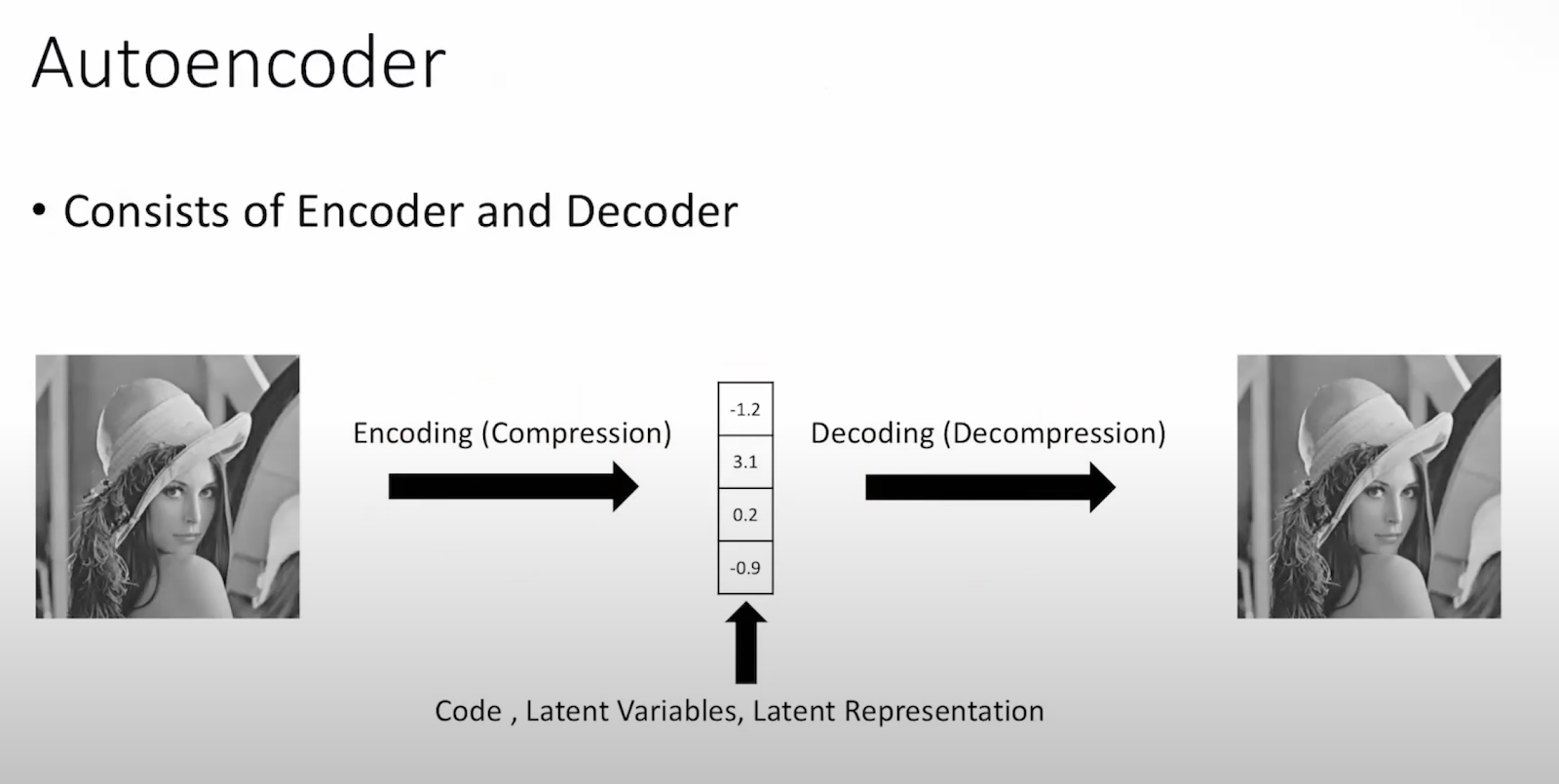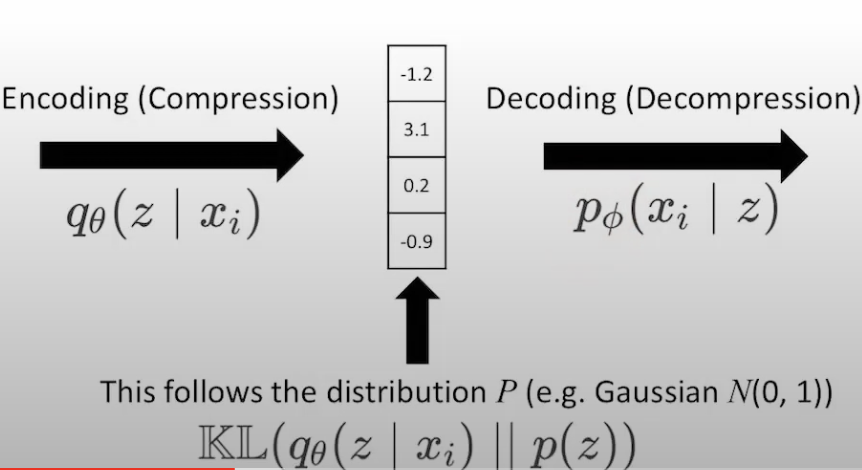[Day 45] Trying to understand VAEs with Professor Choi from KAIST
Hello :)
Today is Day 45!
A quick summary of today:- Learning the theory behind VAEs with Professor Choi from KAIST
- Implementing a VAE from scratch with Aladdin Persson (now probably my 2nd favourite DL youtuber after Andrej Karpathy)
1) Theory behind Variational Auto Encoders (VAEs)
we begin with autoencoders
given an input, they compress it into a lower-dimensional representation, and there is a decoder, that reconstructs the original input from this compressed representation.
What VAEs want to do is with that space in the middle, sample from it and generate new samples.
But that comes with its challenges.
The idea behind VAEs is that we want to estimate the posterior distribution.
We have X, and we want to know the distribution of Z
But that comes with its challenges.
The idea behind VAEs is that we want to estimate the posterior distribution.
We have X, and we want to know the distribution of Z
in reality, estimating the posterio dist is extremely hard, so what we do instead is we approximate P(Z|X) to be pretty similar to a Q(Z) which follows a gaus distribution. But P(Z|X) doesnt always follow a gaus dist, so in those cases doing a Q(Z) like that is not a good choice.
So, if we assume that Q is gaussian, we can get the mean and std of that distribution and tune those so we can more closely approximate P(Z|X)
So how do we learn Q(Z) ? We can minimize KL-divergence
Using some log magic we end up with the below.
In the below formula, logP(X) does not change - that is our data, it is fixed, so what we can do is maximize the ELBO term, this will lead to lowering the KL-divergence. So our job now is to increase the ELBO. In the ELBO term, we know P(Z,X), and from the Q(Z) (which has a gaus dist) we get the mean and std, and we can tune those so that we can maximize the ELBO.
In the below formula, logP(X) does not change - that is our data, it is fixed, so what we can do is maximize the ELBO term, this will lead to lowering the KL-divergence. So our job now is to increase the ELBO. In the ELBO term, we know P(Z,X), and from the Q(Z) (which has a gaus dist) we get the mean and std, and we can tune those so that we can maximize the ELBO.
So, VAE
with VAE with still encode, but now we want the latent space to follow a certain dist (i.e. gaus distribution) so that we can sample and create new samples from it.
next we can denote the encoder and decoder as above.
next we can denote the encoder and decoder as above.
encoder gets X, and generates Z, while the decoder gets Z and generates X
But why do we need the latent space to follow a certain distribution?
because of our goal - wanting to generate new samples. In the case of VAE, when we sample we can just take the decoder, give it a sample and the generated sample will resamble a realistic one. If we sample from a gaus dist, we are more likely to get a sample that will resamble a real one. Whereas in the AE space case, we cannot be sure of that.
How does Loss work ?
In AE, the the X produces Z and then it produces X' and what we do is maximize the ELBO term (tune mu and sigma) to end up with better results. By maximizing the ELBO we minimize the loss. (The ELBO itself can be decomposed into two terms - the reconstruction term and the regularization term (KL-divergence). The reconstruction term measures the reconstruction error of the input data, while the regularization term encourages the latent space distribution to match a predefined prior distribution. By maximizing the ELBO, VAEs encourage the model to learn meaningful latent representations while ensuring that the approximate posterior distribution is close to a predefined prior distribution. The regularization term, enforced by the KL divergence, encourages the latent space distribution to match the predefined prior distribution (typically a gaus dist).
But in VAE the ELBO term is a bit different (with theta and phi).
Side note! it becomes a function of theta and phi (recall earlier 2 pics above that thats what we called the encoder and decoder). In AE, the mean and std are given from X, but here, theta (the encoder) represents a neural network itself and it produces mean and std for each particular sample and using those, we then construct the distribution.
How do we train VAEs? Turns out there is a problem
We get to the right side, get the Loss and now we want to do backprop. We do that, but we end up at Z (that is sampled from the gaus dist). And we cannot differentiate further and we cannot pass this 'stochastic sampling phase' because sampling is not differentiable.
How do we do it then ? By using a so-called 'reparametrization trick'.
How do we do it then ? By using a so-called 'reparametrization trick'.
We have mu and sigma, but in order to 'pass' the sampling from a gaus distribution, we multiply the sigma by an epsilon term which itself is sampled from a gaus distribution. Z follows a mean,std gaus dist, and we can rewrite that Z to be equal to mu + sigma * noise (epsilon is that noise).
I had to double check my notes multiple times and watch the lecture again, so that I can understand the fundamentals. Hopefully I did not make any big mistakes.
I had to double check my notes multiple times and watch the lecture again, so that I can understand the fundamentals. Hopefully I did not make any big mistakes.
2) Implementing a simple VAE
This was a handful, so just to try to understand it a bit more, put the theory to practice I went on youtube and saw VAE from scratch.
Just like in the lecture, we take the image, put it into a hidden layer (theta), then that produces mu and sigma (this is the encoder part). Next, we reparametrize z using mu and sigma and epsilon, and that z goes into the decoder, which turns it to phi, and then turns that back into an image.
The implementation was way easier than the theory behind what is happening haha (as for the loss function, BCELoss was used). But looking at the code, understanding the theory becomes a bit easier.
Now writing this at 1.51am, I realise that the lecture from Professor Choi has practice notebooks, and I checked and it even implements the proper loss (BCE + KLD), but I will go over that quickly tomorrow. I will go to sleep now (zzz)
That is all for today!
See you tomorrow :)












